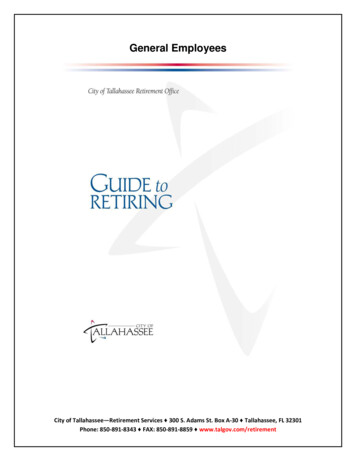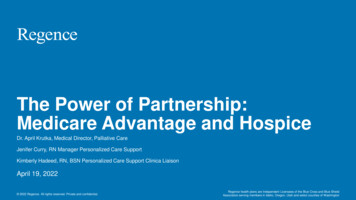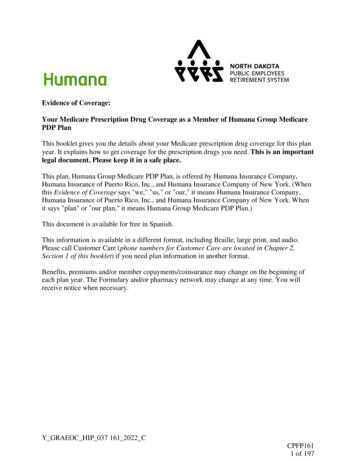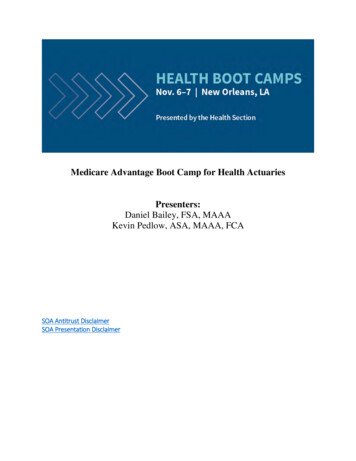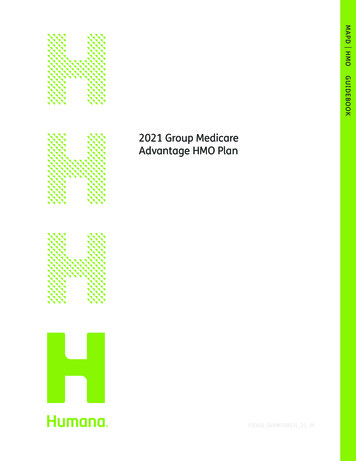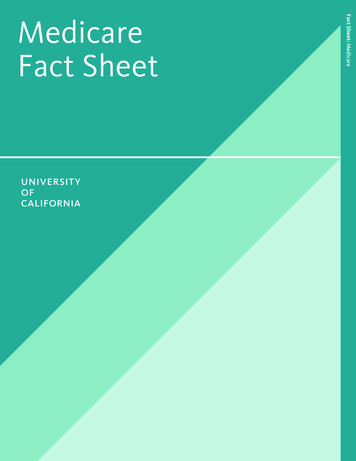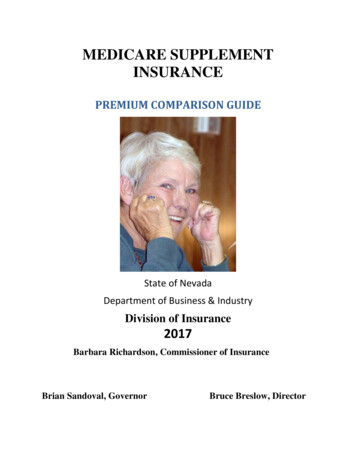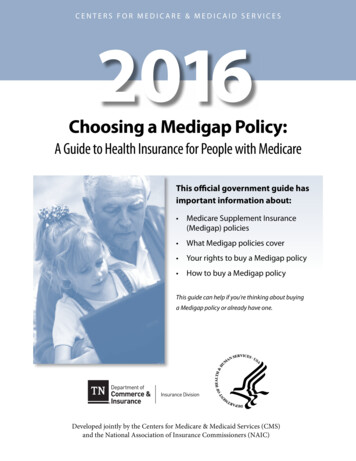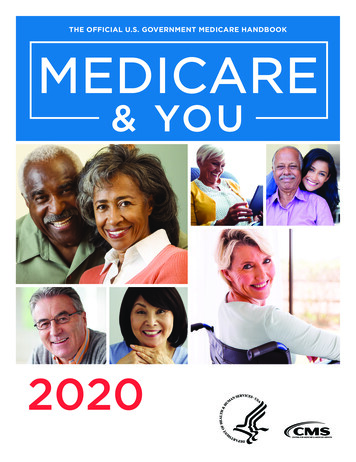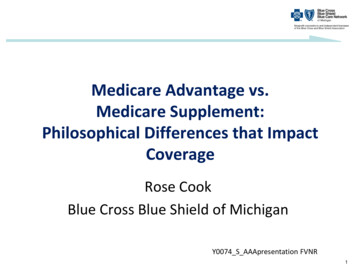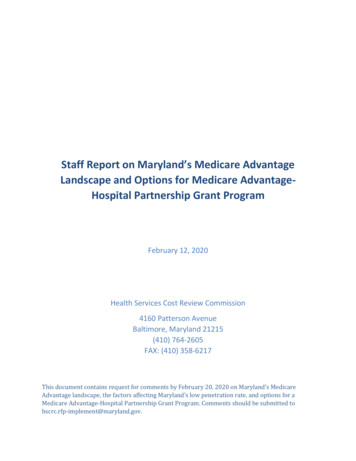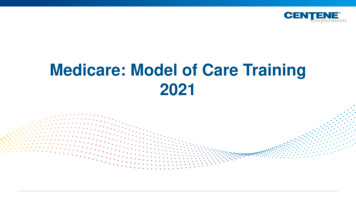
Transcription
Medicare: Model of Care Training2021
Training ObjectivesThis course will describe how Centene and its contracted providers worktogether to successfully deliver the duals Model of Care (MOC) program.After this training, attendees will be able to do the following: Outline the basic components of the Centene Model of Care (MOC) Explain how Centene medical management staff coordinates care ofSpecial Needs members Describe the essential role of providers in the implementation of theMOC program Define the critical role of the provider as part of the MOC requiredInterdisciplinary Care Team (ICT)2
What is a Model of Care? The Model of Care (MOC) is a quality improvement tool that ensuresthe unique needs of each member enrolled in a Special Needs Plan(SNP) are identified and addressed It is Centene’s comprehensive plan for delivering our integratedcare management program for members with special needs It promotes quality measures, care management policy andprocedures and operational systems3
Model of CareThe Affordable Care Act requires the National Committee for QualityAssurance (NCQA) to review and approve all SNP MOCs usingstandards and scoring criteria established by Centers for Medicareand Medicaid (CMS)Establishesscoring criteriaConducts MOCassessment4
Model of Care Training All employees and providers whointeract with SNP members arerequired by CMS to complete annualMOC training. This also includes allmembers of the Interdisplinary CareTeam (ICT) This course is offered to meet theCMS regulatory requirements forMOC Training for our SNPs5
What is a Special Needs Plan (SNP)?Medicare Advantage Special Needs Plans (SNPs) are designed for specificgroups of members with special health care needs. CMS has defined threetypes of SNPs that serve the following types of members:Dual Special Needs Plans (DSNP) Members must have both Medicare and Medicaid benefitsChronic Condition Special Needs Plans (CSNP) Members with a specific chronic illness or illnessesInstitutional Special Needs Plans (ISNP) Members who live in institutions such as: Nursing homes or long term facilityAll Centene Medicare SNP plans consist of DSNPs and CSNPs; Centene Health Planspresently do not have ISNP plans.6
Model of CareThe Model of Care is comprised of four clinical and non-clinical elements:12Description of theSNP PopulationCare Coordination34SNP ProviderNetworkQualityMeasurements &PerformanceImprovement
MOC Element 1Description of SNP Population
Description of Member PopulationMOC Element 1 includes characteristics related to the membership that Centeneand providers serve including demographics, social factors, cognitive factors,environmental factors, living conditions and co-morbidities.This element also includes: Description of most vulnerable population Determining and tracking eligibility Specially tailored services for members How Centene works with community partners9
MOC Element 2Care Coordination
Care CoordinationThe Care Coordination element includes detailed descriptions of the following: How the SNP will coordinate the care of health needs and preferences of the member, andhow care coordination information is shared with members of the Interdisciplinary Care Team(ICT) Listing and explanation of roles of all the persons involved inthe care of the member Contingency plans to avoid disruptions in care Training for all involved in member care and how it isadministered11
Coordinating CareCentene conducts care coordination using the Health Risk Assessment (HRA), anIndividualized Care Plan (ICP) and providing an Interdisciplinary Care Team (ICT).Basic components of care coordination are:HRAICPICTCMS requiredassessment for everySNP member todetermine member’shealth status includingcognitive functions andSDOHsCMS required plan forevery member basedon HRA results thatincludes health goals,barriers andinterventionsCMS required team ofindividuals involved inthe member’s careeither professionally orpersonallyTOCCoordinatingTransitions of Care(TOC) and its impactsto the member’s healthstatus determined bytheir HRA, their ICPand ICT
Health Risk Assessment (HRA)An HRA is conducted to identify medical, psychosocial, cognitive, functional andmental health needs and risks of members. Centene attempts to complete the initial HRA within 90 days of enrollment andannually, or if there is a change in the members condition or transition of care HRA responses are used to identify needs that are incorporated into the member’scare plan and communicated to care team Members are reassessed if there is a change in health condition Change(s) in health condition and annual updates are used to update the care planNote: Physicians should encourage members to complete the HRA in order to bettercoordinate care and create an individual care plan.
Individualized Care Plan (ICP)An Individualized Care Plan (ICP) is developed by theInterdisciplinary Care Team (ICT) in collaboration with the memberCase Managers and PCPs work closely togetherwith the member and their family to prepare,implement and evaluate theIndividualized Care Plan (ICP)
Individualized Care Plan (ICP)Members receive monitoring, service referrals and condition-specificeducation based on their individual needs.Medical condition managementICPs includeproblems,interventions andmeasurable goals,as well asservices themember willreceive.Long-term services and supports (LTSS benefits)Skilled nursing, DME, home healthOccupational therapy, physical therapy, speech therapyBehavioral health and substance use disorderTransportationOther services, as needed
Interdisciplinary Care Team (ICT)Centene Care Managers coordinate the member’s carewith the Interdisciplinary Care Team (ICT) and operateas the single point-of-contact for all ICT membersCentene’s SNP program is member centric. The ICT isbased on the member’s decision of who shouldparticipateThe ICT is designed to provide the expertise needed tomanage the member’s care. The PCP,member/caregiver and the Care Manager make up thecore members of the ICTCentene staff work with members of the ICT incoordinating the plan of care with the member and toencourage self-management of their conditionPrimaryCareProviderOthers asAssignedby erFamilyOtherInternalStaff
ICT ResponsibilitiesCentene works with each member to manage the following: Develop their personal goals and interventions for improving theirhealth outcomes Monitor implementation and barriers to compliance with thephysician’s plan of care Identify/anticipate problems and act as the liaison between themember and their PCP Identify Long Term Services and Supports (LTSS) needs andcoordinate services as applicable
ICT Responsibilities Cont’d Coordinate care and services between the member’s Medicareand Medicaid benefits Educate members about their health conditions and medicationsand empower them to make good healthcare decisions Prepare members/caregivers for their provider visits byencouraging use of personal health record Refer members to community resources as needed Notify the member’s physician of planned and unplannedtransitions
ICT Responsibilities Providers Communicate with, and respond to communicationfrom the plan regarding the member’s care,including accepting meeting invitations whenapplicable Maintaining copies of the ICP and transition ofcare notifications in the member’s medical recordwhen received Collaborating and actively communicating with thefollowing: Centene Case Managers Members of the Interdisciplinary Care Team (ICT) Members and caregivers
ICT CommunicationsMembers of the ICT engage in discussions related to the member’shealth status and care coordination activities through a variety ofmethods:TelephoneGeneral mailSecure e-mailFaxIn personMember etingsOther methods preferred bymember/provider
Transition of Care (TOC)During an episode of illness, members may receive care inmultiple settings, often resulting in fragmented and poorlyexecuted transitions.Centene staff will manage Transitions ofCare (TOC) to ensure that members haveappropriate follow-up carehospitalization or change in levelof care to prevent re-admissions.after
Transition of Care (TOC)Managing TOC interventions for all discharged members mayinclude, but is not limited to, the following:Face-to-face or telephonic contact with the member or their representativein the hospital prior to discharge to discuss the discharge planIn-home visits or phone call within 72 hours post discharge to evaluatemember’s understanding of their discharge plan, medication plan ifapplicable, ensure follow-up appointments have been made, and makecertain the home supports the discharge planOngoing education of members to include preventive health strategies inorder to maintain care in the least restrictive setting possible for their healthcare needs
MOC Element 3Provider Network
Provider NetworkMOC Element 3 explains the specialized expertise in Centene’s provider networkthat is made available to SNP members.Centene is responsible for maintaining a specialized provider network that corresponds to theneeds of our members.This element describes the following: How the network corresponds to the target population How Centene oversees network facilities and providers How providers collaborate with the ICT and contribute to amember’s ICP How Centene coordinates care with and ensures thatproviders:– Provide clinical consultation– Assist with developing and updating care plans24
Provider NetworkCMS Expects Centene to do the following:12345Prioritizecontracting withboard-certifiedprovidersMonitor networkproviders toensure they usenationallyrecognizedclinical practiceguidelines whenavailableEnsure networkproviders arelicensed andcompetentthrough a formalcredentialingprocessDocument theprocess forlinking membersto servicesCoordinate themaintenance andsharing ofmember’s healthcare informationamong providersand the ICT
Provider Network – Who Pays? Medicare is always the primary payer and Medicaid is secondarypayer, unless the service is not covered by Medicare or the Medicareservice benefit cap is exhausted DSNP members have both Medicare and Medicaid but not always withCentene. Medicaid benefits may be via another Health Plan or theState, unless the DSNP is one of the following. It’s important to knowwhat type of DSNP your plan is: Fully Integrated DSNP plans (FIDE) Highly Integrated DSNP plans (HIDE) It’s important to verify coverage prior to providing any services
MOC Element 4Quality Measurement &Performance Improvement
Quality Measurement & Performance ImprovementMOC Element 4 requires SNPs to have performance improvementand quality measurement plans in place.To evaluate success, Centene disseminatesevidence-based clinical guidelines and conductsthe following studies: Measure member outcomes Monitor quality of care Evaluate the effectiveness of theModel of Care (MOC)
Model of Care GoalsCentene determines goals for the MOC related to improvementof the quality of care that members receive.Goals are based on the following: Medicare Stars Measures Consumer Assessment of Healthcare Providers and Systems(CAHPS) Healthcare Effectiveness Data and Information Set (HEDIS) Health Outcomes Survey (HOS)
Model of Care Goals May Include:Access to careMember satisfactionAccess to preventativehealth servicesChronic caremanagement
SummaryThe Model of Care requires all of us to work together to benefit ourmembers through: Enhanced communication between members, physicians, providers and Centene Provide an interdisciplinary and clinically based approach to the member’s specialneeds Employ comprehensive coordination with all partners involved in the member’s care Support the member's preferences in the plan of care Reinforce the member’s self-management capabilities and connections withproviders and support services
Health Plan InformationContact Fidelis Care1-888-FIDELIS (1-888-343-3547)For questions or additional information, please contact Provider Relations Representative.
mental health needs and risks of members. Individualized Care Plan (ICP) . member's health care information among providers and the ICT. . Health Plan Information Contact Fidelis Care 1-888-FIDELIS (1-888-343-3547) For questions or additional information, please contact Provider Relations Representative. .
